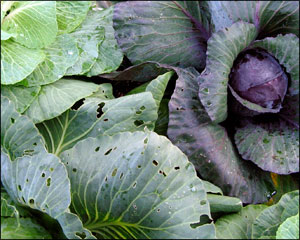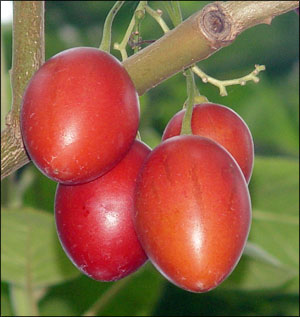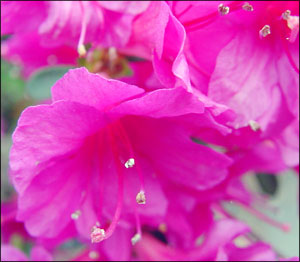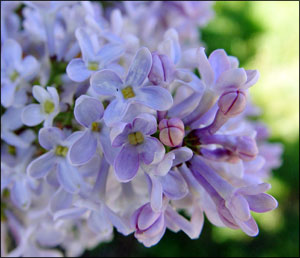Inside The New York Botanical Garden
Sonia Uyterhoeven
Posted in Gardening Tips on June 24 2008, by Sonia Uyterhoeven
Rose Companions
 Sonia Uyterhoeven is Gardener for Public Education at The New York Botanical Garden.
Sonia Uyterhoeven is Gardener for Public Education at The New York Botanical Garden.
 Everyone needs a good friend, and roses are no exception. As the growing season progresses, the tops of roses remain nice and lush, but the bottom can start to look leggy and sparse. Hiding their bare legs with a companion plant is a simple remedy.
Everyone needs a good friend, and roses are no exception. As the growing season progresses, the tops of roses remain nice and lush, but the bottom can start to look leggy and sparse. Hiding their bare legs with a companion plant is a simple remedy.
The wispy flowers and foliage of ornamental sage (Salvia), Russian sage (Perovskia), and catmint (Nepeta) are three good options. Annuals to think about are cherry pie (Heliotrope), Lantana (Lantana), or summer snapdragons (Angelonia).
Aside from aesthetic qualities, some companions are said to protect other plants or enhance their growth. Members of the onion family are rumored to ward off aphids and help prevent black spots, so plant your alliums around your roses. Scented geraniums (Pelargonium), rue (Ruta), and feverfew (Tanacetum) are reported to repel Japanese beetles.
Remember that companions not only need to look good together, but also require compatible growing conditions. Roses perform best in full sun and in soil with good drainage; their companions should do the same.
Posted in Gardening Tips on June 10 2008, by Sonia Uyterhoeven
Cutting Back on Work
 Sonia Uyterhoeven is Gardener for Public Education at The New York Botanical Garden.
Sonia Uyterhoeven is Gardener for Public Education at The New York Botanical Garden.

Have you ever noticed how some plants look just great in the fall? They are nice, neat and full. Generally, that is not the natural growth habit. A little care has to be taken earlier in the season to ensure their fullness, and now is the time.
You can pinch your mums starting in mid to late May to give them a nice full shape. An easier option is to wait until mid-June and just sheer them back by about half. I take a good pair of hedge sheers and cut them so they look like nice, rounded domes. They will keep the shape as they grow throughout the summer.
If you don’t have sheers, just take your bypass pruners to make your cuts. Remember, gardening is not an exact science, so just shape them so they look nice. What you are doing with the cuts (heading cuts) is encouraging lateral shoots (side shoots) to branch out and create a more compact, full shape.
With our tall Korean mums, which are the envy of every visitor in late October through early September, we cut them back twice. The initial cut is in mid-June and the second cut happens three weeks later, around July 4. The holiday is a helpful reminder of the cut-off date. If you continue sheering these late season bloomers throughout the summer, they will flower too late in the season and get knocked back by the frost.
Asters also get cut back in this fashion. Often we further support our asters by placing a peony hoop over them early in the season. These hoops are raised as the plant grows to give added support.
You don’t have to limit yourself to these two classics. Beebalm (Monarda) responds well to this treatment, as does Joe Pye weed (Eupatorium), Helen’s flower (Helenium), and a whole host of perennials.
Posted in Gardening Tips on June 3 2008, by Sonia Uyterhoeven
Weed-Free Heaven
 Sonia Uyterhoeven is Gardener for Public Education at The New York Botanical Garden.
Sonia Uyterhoeven is Gardener for Public Education at The New York Botanical Garden.
 Gardening is much like housekeeping—as long as you keep on top of things nothing will get the best of you. Following a few simple rules and some good horticultural practices will ensure that you don’t end up being swamped with one big green mess.
Gardening is much like housekeeping—as long as you keep on top of things nothing will get the best of you. Following a few simple rules and some good horticultural practices will ensure that you don’t end up being swamped with one big green mess.
Here are a few tips to keep weeds at bay:
Keep your garden a reasonable size, stagger your spring planting (remember freshly cultivated soil is an invitation for weeds), choose low maintenance plants, weed often (spend ½ hour a few times a week to keep your garden weed-free), attack flowering weeds first (don’t let them go to seed), hoe when the ground is dry, and hand pull when the ground is wet.
Posted in Gardening Tips on May 27 2008, by Sonia Uyterhoeven
Annual Affairs
 Sonia Uyterhoeven is Gardener for Public Education at The New York Botanical Garden.
Sonia Uyterhoeven is Gardener for Public Education at The New York Botanical Garden.
 For nonstop color in the garden, you really can’t beat annuals. For those of you who are not blessed with bright sunshine, last year we featured quite a few begonias in the Garden and I have a deepening respect for the plants.
For nonstop color in the garden, you really can’t beat annuals. For those of you who are not blessed with bright sunshine, last year we featured quite a few begonias in the Garden and I have a deepening respect for the plants.
We planted a number of Rex Begonias as an ornamental ground cover. During the latter half of the summer I would make flashy floral centerpieces by combining the begonia’s bright foliage with the silver-pink swirls of roses and hydrangeas. When I lived in Massachusetts, I used to keep my dappled borders bright with the nonstop begonias (tuberous begonias). The apricot and pinks were so beautiful that I would add them to shady containers to complement my coleus and fuchsias.
Read More
Posted in Gardening Tips on May 20 2008, by Sonia Uyterhoeven
Cabbage Worms
 Sonia Uyterhoeven is Gardener for Public Education at The New York Botanical Garden.
Sonia Uyterhoeven is Gardener for Public Education at The New York Botanical Garden.
 Cabbages make an excellent early season crop. Plant them in early to mid April and you will have a nice harvest by mid-June. Sometime in May you may see a pretty little white butterfly hovering around your cabbages, and shortly thereafter you will notice some holes appearing in your leaves until the beautiful, glaucous foliage looks more like Swiss cheese. You have cabbage worms. The easiest way to control this problem is to send your kids out and have them handpick the small green caterpillars (the culprits for all the holes).
Cabbages make an excellent early season crop. Plant them in early to mid April and you will have a nice harvest by mid-June. Sometime in May you may see a pretty little white butterfly hovering around your cabbages, and shortly thereafter you will notice some holes appearing in your leaves until the beautiful, glaucous foliage looks more like Swiss cheese. You have cabbage worms. The easiest way to control this problem is to send your kids out and have them handpick the small green caterpillars (the culprits for all the holes).
Read More
Posted in Gardening Tips on May 13 2008, by Sonia Uyterhoeven
Tomato Time
 Sonia Uyterhoeven is Gardener for Public Education at The New York Botanical Garden
Sonia Uyterhoeven is Gardener for Public Education at The New York Botanical Garden
 I love growing tomatoes; they are easy, tasty, and fun. One year I had a friend who started heirloom varieties from seed. She gave her leftover seedlings to any willing recipient—and I was one of them. I had a small community plot at that time, and I waited with anticipation for the large heirlooms to ripen. The day before I was planning on picking a prized tomato, a woodchuck paid a visit to the garden and took just one big bite out of the tomato.
I love growing tomatoes; they are easy, tasty, and fun. One year I had a friend who started heirloom varieties from seed. She gave her leftover seedlings to any willing recipient—and I was one of them. I had a small community plot at that time, and I waited with anticipation for the large heirlooms to ripen. The day before I was planning on picking a prized tomato, a woodchuck paid a visit to the garden and took just one big bite out of the tomato.
Heirlooms are wonderful—they are some of the tastiest tomatoes available. However, some of the modern hybrids tend to be more disease resistant and more prolific, so I try and make a habit of including some of each in my garden.
Last year, not by choice, I experimented with growing tomatoes in an area that didn’t receive enough sunlight. The result was a beautiful crop of green beefsteak tomatoes that I dipped in an egg and breadcrumb batter. The fried green tomatoes were so good that I am tempted to grow them in the same spot this year!
This year I plan on experimenting with Earthboxes and other self-watering containers. A few rules with tomatoes: plant them deep (place part of the stem underground and it will produce a beautiful, strong root system), give them sun (the more you can give them, the happier they will be), and keep them well-watered (consistency is the key).
Posted in Gardening Tips on May 6 2008, by Sonia Uyterhoeven
Amazing Azaleas
 Sonia Uyterhoeven is Gardener for Public Education at The New York Botanical Garden.
Sonia Uyterhoeven is Gardener for Public Education at The New York Botanical Garden.
 One of my favorite springtime plants is the native azalea. It is a versatile shrub that is often overlooked by homeowners. Azaleas have spectacular blooms in spring, some are incredibly fragrant (nice and spicy), and many have outrageous fall color.
One of my favorite springtime plants is the native azalea. It is a versatile shrub that is often overlooked by homeowners. Azaleas have spectacular blooms in spring, some are incredibly fragrant (nice and spicy), and many have outrageous fall color.
Most native azaleas grow from 5 to 8 feet tall and rarely need any pruning. Like all members of the heath family (Ericaceae), they prefer acidic soil and like their feet kept cool because of their shallow roots (apply good leaf litter or mulch at their base).
These shrubs thrive in partial sunlight. Native azaleas flower from late April into July in this part of the world. Try the Pinxterbloom Azalea (Rhododendron periclymenoides) and the Pinkshell Azalea (Rhododendron vaseyi) for early season bloom and end with the Cumberland Azalea (Rhododendron bakeri) or the evergreen Plum-leaf Azalea (Rhododendron prunifolium). They make fairly easy-going companions for your garden.
Posted in Gardening Tips on April 29 2008, by Sonia Uyterhoeven
Lovely Lilacs
 Sonia Uyterhoeven is Gardener for Public Education at The New York Botanical Garden.
Sonia Uyterhoeven is Gardener for Public Education at The New York Botanical Garden.
 For those of you who love lilacs but are deprived of space, dwarf lilacs are something to think about. Some of them have nice fall color and they are small and compact, need minimal pruning, and tend to be more resistant to the powdery mildew that plagues many lilacs at the end of the season.
For those of you who love lilacs but are deprived of space, dwarf lilacs are something to think about. Some of them have nice fall color and they are small and compact, need minimal pruning, and tend to be more resistant to the powdery mildew that plagues many lilacs at the end of the season.
Two varieties that you will be able to find in any nursery these days are Syringa meyeri ‘Palibin’ and Syringa pubescens subsp. patula ‘Miss Kim’. Don’t be intimidated by the long Latin names; if you mutter lilac ‘Miss Kim’ or ‘Palibin’ everyone will know what you are talking about.
Read More
Posted in Gardening Tips on January 26 2008, by Sonia Uyterhoeven
A Weedy Mess: Keeping My Life in Order
 Sonia Uyterhoeven is Gardener for Public Education at The New York Botanical Garden.
Sonia Uyterhoeven is Gardener for Public Education at The New York Botanical Garden.
I am always surprised with the long weekends that we have in January and February. I seem to remember all the other holidays, except for the ones that sneak up in mid-winter. Since I never plan for them, they turn into three days of extended housecleaning. The piles on my desk diminish and bills finally get filed in the right place. During these moments, I swear to good housekeeping practices that I never abide by.
Read More
 Sonia Uyterhoeven is Gardener for Public Education at The New York Botanical Garden.
Sonia Uyterhoeven is Gardener for Public Education at The New York Botanical Garden. Everyone needs a good friend, and roses are no exception. As the growing season progresses, the tops of roses remain nice and lush, but the bottom can start to look leggy and sparse. Hiding their bare legs with a companion plant is a simple remedy.
Everyone needs a good friend, and roses are no exception. As the growing season progresses, the tops of roses remain nice and lush, but the bottom can start to look leggy and sparse. Hiding their bare legs with a companion plant is a simple remedy.



 Cabbages make an excellent early season crop. Plant them in early to mid April and you will have a nice harvest by mid-June. Sometime in May you may see a pretty little white butterfly hovering around your cabbages, and shortly thereafter you will notice some holes appearing in your leaves until the beautiful, glaucous foliage looks more like Swiss cheese. You have cabbage worms. The easiest way to control this problem is to send your kids out and have them handpick the small green caterpillars (the culprits for all the holes).
Cabbages make an excellent early season crop. Plant them in early to mid April and you will have a nice harvest by mid-June. Sometime in May you may see a pretty little white butterfly hovering around your cabbages, and shortly thereafter you will notice some holes appearing in your leaves until the beautiful, glaucous foliage looks more like Swiss cheese. You have cabbage worms. The easiest way to control this problem is to send your kids out and have them handpick the small green caterpillars (the culprits for all the holes). I love growing tomatoes; they are easy, tasty, and fun. One year I had a friend who started heirloom varieties from seed. She gave her leftover seedlings to any willing recipient—and I was one of them. I had a small community plot at that time, and I waited with anticipation for the large heirlooms to ripen. The day before I was planning on picking a prized tomato, a woodchuck paid a visit to the garden and took just one big bite out of the tomato.
I love growing tomatoes; they are easy, tasty, and fun. One year I had a friend who started heirloom varieties from seed. She gave her leftover seedlings to any willing recipient—and I was one of them. I had a small community plot at that time, and I waited with anticipation for the large heirlooms to ripen. The day before I was planning on picking a prized tomato, a woodchuck paid a visit to the garden and took just one big bite out of the tomato. One of my favorite springtime plants is the native azalea. It is a versatile shrub that is often overlooked by homeowners. Azaleas have spectacular blooms in spring, some are incredibly fragrant (nice and spicy), and many have outrageous fall color.
One of my favorite springtime plants is the native azalea. It is a versatile shrub that is often overlooked by homeowners. Azaleas have spectacular blooms in spring, some are incredibly fragrant (nice and spicy), and many have outrageous fall color. For those of you who love lilacs but are deprived of space, dwarf lilacs are something to think about. Some of them have nice fall color and they are small and compact, need minimal pruning, and tend to be more resistant to the powdery mildew that plagues many lilacs at the end of the season.
For those of you who love lilacs but are deprived of space, dwarf lilacs are something to think about. Some of them have nice fall color and they are small and compact, need minimal pruning, and tend to be more resistant to the powdery mildew that plagues many lilacs at the end of the season.